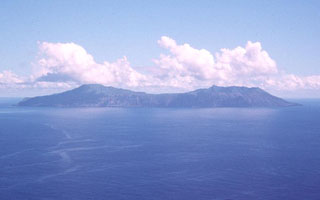Report on Anatahan (United States) — October 1990
Bulletin of the Global Volcanism Network, vol. 15, no. 10 (October 1990)
Managing Editor: Lindsay McClelland.
Anatahan (United States) Crater lake refills; little deformation or seismicity
Please cite this report as:
Global Volcanism Program, 1990. Report on Anatahan (United States) (McClelland, L., ed.). Bulletin of the Global Volcanism Network, 15:10. Smithsonian Institution. https://doi.org/10.5479/si.GVP.BGVN199010-284200
Anatahan
United States
16.35°N, 145.67°E; summit elev. 790 m
All times are local (unless otherwise noted)
A seven-member team of USGS volcanologists visited the CNMI 24 September-6 October at the request of the Office of Civil Defense. The team installed [a seismic station] on Anatahan . . .; data are telemetered to Saipan and recorded at Civil Defense headquarters. Quoted material below is from a report by Richard Moore.
"No significant earthquakes have occurred on Anatahan since installation of the seismic and telemetry system on 29 September. Reoccupation of the EDM network established in April showed small changes in line lengths, in accord with the lack of local seismicity. The lake in the eastern crater . . . was full again on 1 October 1990. The water was discolored, but not boiling."
Felt seismicity 30 March-1 April and turbulence in the crater lake of Anatahan prompted the evacuation of Anatahan Island. The island has remained uninhabited since 4 April.
Geological Summary. The elongate, 9-km-long island of Anatahan in the central Mariana Islands consists of a large stratovolcano with a 2.3 x 5 km compound summit caldera. The larger western portion of the caldera is 2.3 x 3 km wide, and its western rim forms the island's high point. Ponded lava flows overlain by pyroclastic deposits fill the floor of the western caldera, whose SW side is cut by a fresh-looking smaller crater. The 2-km-wide eastern portion of the caldera contained a steep-walled inner crater whose floor prior to the 2003 eruption was only 68 m above sea level. A submarine cone, named NE Anatahan, rises to within 460 m of the sea surface on the NE flank, and numerous other submarine vents are found on the NE-to-SE flanks. Sparseness of vegetation on the most recent lava flows had indicated that they were of Holocene age, but the first historical eruption did not occur until May 2003, when a large explosive eruption took place forming a new crater inside the eastern caldera.
Information Contacts: R. Moore, USGS; R. Koyanagi and M. Sako, HVO.

